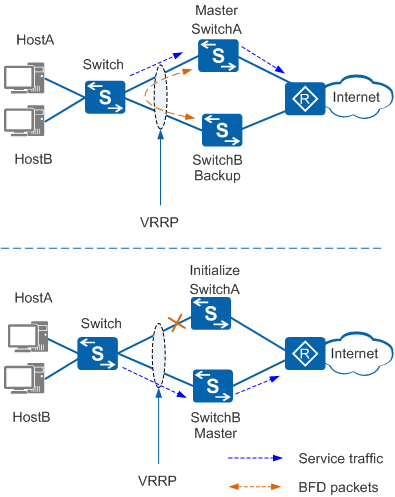Association Between VRRP and BFD
A VRRP group sends and receives VRRP Advertisement packets to determine the master and backup states, thereby implementing redundancy. If links connected to a VRRP group fail, VRRP Advertisement packets cannot be sent for negotiation. A backup will switch to the master after three VRRP Advertisement packet sending intervals (about 3s). During this switchover period, service traffic is still sent to the original master, causing loss of user traffic.
BFD can rapidly detect connectivity of links on the network. Association between VRRP and BFD implements a fast switchover (less than 1 second). A BFD session is set up between the master and backup and is bound to a VRRP group. BFD can detect faults of the VRRP group after which it instructs the VRRP group to perform an active/standby switchover, greatly reducing the service interruption time.
A VRRP group can be associated with a static BFD session or a BFD session with automatically negotiated parameters.
There are two modes of association between VRRP and BFD: common mode and peer mode. Table 1 compares the two modes.
Association Mode |
Usage Scenario |
Impact |
Device Setting |
|---|---|---|---|
Common mode NOTE:
Only the S5720-EI, S5720-HI, S5720I-SI, S5720S-SI, S5720-SI, S5735-S, S5735S-S, S5735-S-I, S5730-HI, S5730S-EI, S5730-SI, S5731-H, S5731-S, S5731S-H, S5731S-S, S5732-H, S6720-EI, S6720-HI, S6720S-EI, S6720S-SI, S6720-SI, S6730-H, S6730S-H, S6730-S, and S6730S-S support this mode. |
The backup detects whether the master works properly, and the BFD session is often used to monitor the status of the link between the master and backup. |
The VRRP group adjusts its priority according to the BFD session status and determines whether to perform an active/standby switchover according to the adjusted priority. |
The device configured with VRRP must support BFD. |
Peer mode NOTE:
Only the S5720-HI, S5730-HI, S5731-H, S5731-S, S5731S-H, S5731S-S, S5732-H, S6720-HI, S6730-H, S6730S-H, S6730-S, and S6730S-S support this mode. |
The backup detects whether the master works properly, and the BFD session is often used to monitor the status of the link between the master and backup. |
When the peer BFD session status changes, the VRRP device's priority remains unchanged and the VRRP group status is reconfigured. |
The device configured with VRRP must support BFD. |
As shown in Figure 1, a VRRP group is configured between SwitchA and SwitchB. SwitchA is the master and SwitchB is the backup. User traffic is forwarded through SwitchA. SwitchA and SwitchB work in preemption mode, and immediate preemption is configured on SwitchB. BFD sessions are configured on SwitchA and SwitchB and association between VRRP and BFD is configured on SwitchB.
When a fault occurs in the VRRP group, BFD rapidly detects the fault and instructs SwitchB to increase its priority to a value higher than that of SwitchA. SwitchB immediately switches to the master and forwards user-side traffic, implementing a rapid active/standby switchover.
